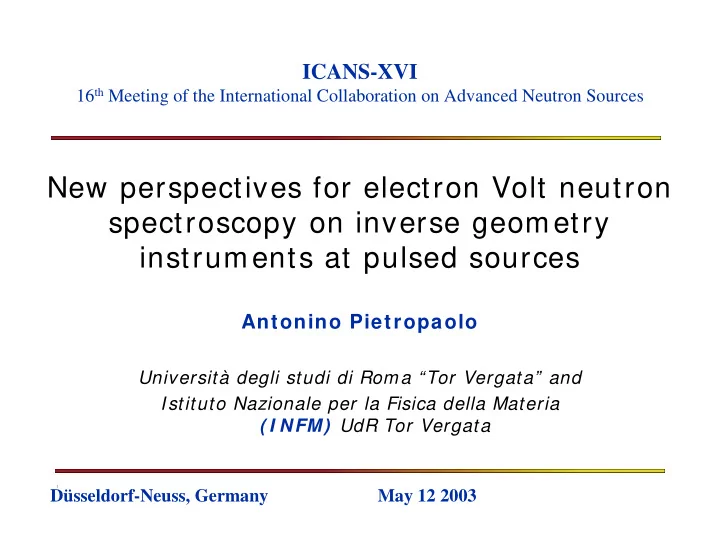

ICANS-XVI 16 th Meeting of the International Collaboration on Advanced Neutron Sources New perspectives for electron Volt neutron spectroscopy on inverse geometry instruments at pulsed sources Antonino Pietropaolo Università degli studi di Roma “Tor Vergata” and Istituto Nazionale per la Fisica della Materia ( I NFM) UdR Tor Vergata Düsseldorf-Neuss, Germany May 12 2003
THE EXPERIMENTAL TEAM • University of Rome Tor Vergata and INFM . – Carla Andreani, Antonino Pietropaolo, Roberto Senesi • University of Rome Tor Vergata and INFN : – Annalisa D’Angelo • University of Roma Tre and INFM : – Silvia Imberti • University of Milano-Bicocca and INFM : – Giuseppe Gorini, Marco Tardocchi • ISIS Facility – Nigel J. Rhodes, Erik M. Schooneveld Düsseldorf-Neuss, Germany May 12 2003
OVERVIEW • Applications of epithermal neutrons; • The inverse geometry configuration: - The Resonance Filter Spectrometer ( RFS ) configuration - The Resonance Detector Spectrometer ( RDS ) configuration • Some experimental results on VESUVIO at ISIS with RDS set up and comparison with RFS • Possible applications of RDS on VESUVIO • Conclusions Düsseldorf-Neuss, Germany May 12 2003
Epithermal Neutron Spectroscopy • Deep Inelastic Neutron Scattering (DINS) Investigation of the single particle properties of both quantum systems and molecular fluids and solids – Momentum distribution n(p) – Mean kinetic energy <E k > ω ≥ ≥ – Impulse Approximation: 1 eV , q Å -1 h 20 • Inelastic Neutron Scattering High energy excitations in a variety of systems ω ≥ h – 1 eV , q < 10 Å -1 small angle scattering and E i and E f well above 1 eV Düsseldorf-Neuss, Germany May 12 2003
The inverse geometry configuration sample moderator L 0 L 1 velocity selector m L L neutron counter t = t+ t = 0 + 1 D k k h acquisition 0 1 Düsseldorf-Neuss, Germany May 12 2003
How to select the final neutron energy in the 1-100 eV range • No choppers – Neutrons are too fast • No crystal analysers – Neutrons have too short λ Then … • Nuclear resonances – Two different experimental configurations ……… Düsseldorf-Neuss, Germany May 12 2003
The Resonance Filter Spectrometer p bunch start target Li-glass detector n stop P n’ DAE M T sample electronic chain filter TOF spectra Düsseldorf-Neuss, Germany May 12 2003
Filter Difference Method 6 Li-glass (Ce) α P n λ n M electronic PHOTONS DAE chain T t η Li-glass ! 1/v For VESUVIO’s detector above 20 eV heavy detection efficiency loss Düsseldorf-Neuss, Germany May 12 2003
The Resonance Detector Spectrometer p bunch target start n γ detector stop X Fast n’ DAE electronic chain γ sample Analyser foil TOF (n, γ ) reactions spectra Düsseldorf-Neuss, Germany May 12 2003
DINS measurements on a Pb sample 238 U analyser copuled to a CZT detector thermal region: diffraction peaks E r [eV]: 6.67 20.80 epithermal region: 36.60 recoil peaks 66.00 Düsseldorf-Neuss, Germany May 12 2003
A comparison with Li-glass detectors • 50 µm thick Uranium foil (15 cm x 15 P/B " 0.1 cm). P/B " 0.3 • Detector at 90° at wall at 30 cm from P/B " 0.6 P/B " 1 the sample • Lower Level Discriminator at 40 keV. P/B " 0.1 • Peak to Background (P/B) ratio much P/B " 0.2 better for CZT rather than for Li-glass P/B " 0.3 detector. Düsseldorf-Neuss, Germany May 12 2003
Extracting n(p) and < E k > It has been possible to measure the recoil up to final neutron energy of about 70 eV. In the RFS configuration only the first two peaks can be analysed Düsseldorf-Neuss, Germany May 12 2003
The CZT solid state detector ~10 cm crystal size: 5 x 5 x 5 mm 3 Düsseldorf-Neuss, Germany May 12 2003
DINS measurements on a Pb sample 238 U coupled to a YAP scintillator 600 keV LLD (short run) P/B " 0.1 P/B " 10 P/B " 5.5 P/B " 0.4 P/B " 0.6 P/B " 0.8 P/B " 2.7 P/B " 6 40 keV LLD Düsseldorf-Neuss, Germany May 12 2003
A comparison with Li-glass • Position : 1 m from sample at 25 degree, next to Li-glass detector. P/B " 0.04 • U-foil : 50 µm thick, size 3.5 cm * P/B " 0.10 2.5 cm. • LLD : 600 keV. P/B " 0.2 P/B " 0.35 P/B " 0.6 • YAP has much better Peak to Background (P/B) ratio as compared to Li-glass. P/B " 0.6 Düsseldorf-Neuss, Germany May 12 2003
RDS for VLAD on VESUVIO • Construction of a Filter changer detector bank in forward scattering (1°< 2 θ < 5°) VLAD: an array of γ detectors with good spatial resolution • Fast electronics for a finer time sampling at higher final energies n CZT and YAP are good candidates Düsseldorf-Neuss, Germany May 12 2003
Accessing unexplored kinematical regions E f = 72.0 eV (lantanum) E f = 6.671 eV (uranium) Düsseldorf-Neuss, Germany May 12 2003
Conclusions • It is interesting accessing unexplored kinematical regions for neutron spectroscopy such as high ħ ω coupled to low q (small angle scattering): investigation of high energy excitations in several systems ranging from magnetic materials to semiconductors • High energy neutrons have to be detected and…. • A proper detection approach is needed: RDS – Effective up to 70 eV final neutron energy – Efficiency independent from E n – Beam time not shared between foil-in and foil-out as in RFS Düsseldorf-Neuss, Germany May 12 2003
• CZT solid state detectors and YAP scintillators can be considered good candidates for VLAD on VESUVIO at ISIS • Beyond the specific objectives presented here, it is important to improve the RDS performances (testing new detectors) so to provide an effective instrumentation for inverse geometry epithermal neutron spectrometers operating at new generation pulsed sources. Düsseldorf-Neuss, Germany May 12 2003
Recommend
More recommend